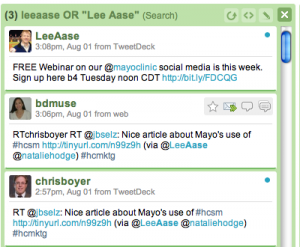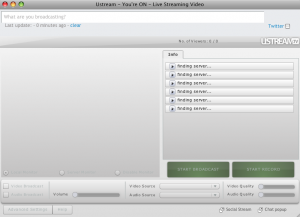I have enjoyed working with Chris Seper at MedCity News (on this story, for example) but I think he misses the point of @EdBennett‘s list of hospitals ranked by number of Twitter followers.
And therefore I think his recommendation also is off.
Certainly some hospitals (and other organizations) have just had their Twitter accounts on autopilot, sending Tweets based on an RSS feed. If they’ve done that, though, they aren’t putting a lot of effort (or any time) into Twitter. So even if they don’t have a lot of followers, you can’t really say the project has been a failure, because the cost has been essentially zero. We did this for several months with our @mayoclinic account at the start, and while it isn’t the best approach it can be a good defensive move (see my bottom-line recommendation below.)
But comparing hospitals to celebrities like Ashton Kutcher makes no sense. In fact, as I wrote in a comment (currently awaiting moderation) on the post Chris did about Ed’s list:
Look at the TV stations in the Cleveland market: @wkyc – 3883 followers; @fox8news 2,686; @19ActionNews 1,520; @WEWS 2,098. Only one of those would crack the top 5 hospitals, and one wouldn’t match the hospital numbers at all.
I think Chris is presenting not just a false choice, but a wrong-headed recommendation, when he says:
Hospitals may be better served setting up accounts for high-profile doctors and managing those accounts, rather than trying to gain followers for an institution.
I think this is wrong on two counts:
First, it isn’t an either/or situation, i.e. to develop an institutional Twitter presence OR encourage individual physicians to engage. There is a place for both.
Second, if the alternative would be “setting up accounts for high-profile doctors and managing those accounts” then that’s really missing the point of social media. Public affairs staff can provide guidance and training for MDs who want to use Twitter, but as Ed says, “docs will do SM on their own if so inclined. Hospitals can’t make them do it.” And hospital PR staff shouldn’t pose as MDs and “manage” accounts for them.
I’m pleased with the progress we’ve made on our @mayoclinic account: our number of followers has quadrupled in the last six months as we have become more interactive. And we also have individual physicians like @vmontori and @davidrosenman getting active in Twitter. They’re both doing some really interesting innovation projects in health care, and are interested in the application of social media.
But we’re not managing the accounts for Dr. Rosenman or Dr. Montori. And the reason DrVes, Dr Val and KevinMD have gained lots of followers is because of their personal involvement, not because someone has “managed” their accounts for them.
The Bottom Line:
- Hospitals, or other organizations for that matter, should have a Twitter account, if for no other reason than to keep someone from brandjacking them. But the more they engage, the more valuable they will find even this corporate account.
- They should encourage and train individuals who are interested to get involved personally. You can’t manufacture passion, though. If doctors and other leaders are excited about engaging, they will likely be successful. But ghost-tweeting by PR staff would be the wrong approach.

